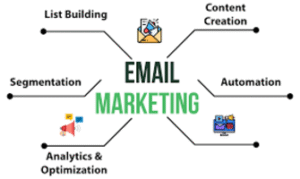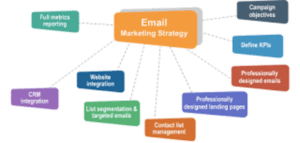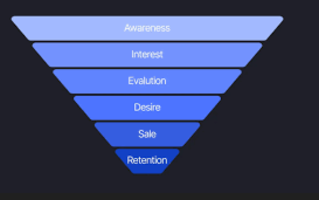Have you ever wondered why some businesses seem to effortlessly connect with their audience through email while others watch their messages disappear into the dreaded spam folder? The difference usually comes down to one crucial element: a well-crafted email marketing strategy, which is why tips on how to create an effective email strategy is so important.
In today’s digital landscape, email marketing remains one of the most powerful tools for businesses to reach customers directly, build meaningful relationships, and drive consistent revenue. Email marketing isn’t just about sending promotional messages to a list of contacts. It’s about creating a systematic approach that nurtures relationships, delivers value, and converts subscribers into loyal customers.
With the average return on investment for email marketing sitting at an impressive $36 for every dollar spent, getting your email marketing strategy right has never been more important. Throughout this guide, we’ll explore the foundational principles, proven frameworks, and practical tactics that will help you build an email marketing strategy that actually works.
Understanding the Foundation of Email Marketing Strategy
At its core, a strong strategy combines clear objectives with audience understanding, compelling content, and consistent optimization. Think of your email marketing strategy as a roadmap that guides every message you send, ensuring each email serves a specific purpose in your customer journey.
The most successful email marketers recognize that their strategy must align with broader business goals. Whether you’re aiming to increase sales, build brand awareness, nurture leads, or strengthen customer loyalty, your email marketing efforts should directly support these objectives. This alignment ensures that every campaign contributes meaningfully to your bottom line rather than simply adding noise to your subscribers’ inboxes.
Building Your Email List the Right Way- How to Create an Effective Email Marketing Strategy
Your email marketing strategy is only as strong as the quality of your subscriber list. Growing a healthy, engaged email list requires patience and ethical practices. Gone are the days when businesses could purchase lists and blast generic messages to disinterested recipients. Today’s effective email marketing strategy starts with permission-based list building.
Focus on attracting subscribers who genuinely want to hear from you. Offer valuable incentives like exclusive content, helpful resources, discount codes, or insider information that makes signing up worthwhile. Your signup forms should be strategically placed on your website, social media profiles, and during checkout processes. Make the value proposition crystal clear so potential subscribers understand exactly what they’ll receive and how often they’ll hear from you.
Segmentation plays a vital role from the very beginning. Even as you’re building your list, collect information that allows you to group subscribers based on their interests, behaviors, or demographics. This foundational work pays dividends later when you’re crafting targeted campaigns that resonate with specific audience segments.
What does email marketing’s Rule of 7 mean?- How to Create an Effective Email Marketing Strategy
The rule of 7 in email marketing suggests that a potential customer needs to encounter your brand or message at least seven times before they’re ready to make a purchase decision. This marketing principle, which has roots in traditional advertising, remains remarkably relevant in the email marketing world. Understanding and applying the rule of 7 helps you create more patient, persistent email marketing campaigns that nurture relationships over time rather than pushing for immediate conversions.
In practical terms, the rule of 7 means you shouldn’t expect your first email to convert a subscriber into a customer. Instead, view your email marketing strategy as a series of touch points that gradually build trust, demonstrate value, and establish your brand as the preferred solution to your audience’s problems. Your welcome series might be the first touch point, followed by educational content, social proof, product demonstrations, limited-time offers, testimonials, and finally, a compelling call to action.
The beauty of email marketing is that these seven touch points don’t have to be identical promotional messages. They can include helpful blog posts, industry insights, customer success stories, behind-the-scenes content, and value-driven emails that educate rather than sell. By the time your subscriber reaches that seventh touchpoint, they’ve experienced enough of your brand to make an informed purchasing decision.

What are the 4 P’s of Email Marketing?- How to Create an Effective Email Marketing Strategy
The 4 P’s of email marketing provide a strategic framework for creating campaigns that consistently deliver results. These four essential elements work together to ensure your email marketing efforts are comprehensive and effective.
Purpose
Every email you send must have a clear, defined purpose. Are you welcoming new subscribers, promoting a product, sharing valuable content, or re-engaging inactive customers? Your purpose shapes everything from your subject line to your call to action. Emails without a clear purpose confuse recipients and rarely achieve meaningful results. Before crafting any campaign, ask yourself what specific action you want recipients to take and build your entire message around facilitating that action.
Personalization
Generic, one-size-fits-all emails no longer cut it in today’s competitive inbox environment. Personalization goes far beyond inserting a subscriber’s first name in the subject line. It involves tailoring content based on subscriber behavior, preferences, purchase history, and engagement patterns. Use the data you’ve collected to send relevant product recommendations, location-specific offers, or content that aligns with expressed interests. The more personalized your emails feel, the higher your engagement rates will climb.
Performance
Measuring and analyzing your email marketing performance is non-negotiable for continuous improvement. Track key metrics like open rates, click-through rates, conversion rates, bounce rates, and unsubscribe rates. These numbers tell the story of what’s working and what isn’t. Regular performance analysis allows you to identify successful patterns, spot problems early, and make data-driven decisions about future campaigns. Set benchmarks for your industry and strive to consistently meet or exceed them.
Precision
Precision in email marketing means sending the right message to the right person at the right time. This involves strategic timing, careful segmentation, and thoughtful automation. Rather than blasting your entire list with every campaign, use precision targeting to ensure your messages reach only those subscribers most likely to find them relevant. Test different send times to discover when your audience is most receptive, and use automation to trigger emails based on specific behaviors or milestones.
What are the 5 Ts of Email Marketing?-How to Create an Effective Email Marketing Strategy
The 5 Ts of email marketing represent five critical components that work together to create successful campaigns. Mastering these elements significantly increases your chances of email marketing success.
Tease
Your subject line is your first and often only chance to capture attention. The tease element is about crafting subject lines that spark curiosity, promise value, or create urgency without resorting to clickbait tactics. Great subject lines are specific, benefit-focused, and appropriate for your brand voice. They give subscribers a compelling reason to open your email while setting accurate expectations about what’s inside.
Target
Effective targeting ensures your messages reach the most receptive audience segments. Rather than sending identical emails to your entire list, divide subscribers into meaningful groups based on demographics, behavior, purchase history, or engagement levels. A targeted approach allows you to craft messages that feel personally relevant to each segment, dramatically improving your response rates.
Teach
Educational content establishes your brand as a trusted authority in your field. The teach element involves sharing valuable insights, solving problems, or providing information that improves your subscribers’ lives or businesses. When you consistently teach through your emails, you build credibility and trust that naturally leads to conversions when subscribers are ready to make a purchase.
Test
Continuous testing is the engine of email marketing improvement. Test different subject lines, email designs, calls to action, send times, and content formats to discover what resonates most with your audience. A/B testing removes guesswork from your strategy and provides concrete data about subscriber preferences. Even small improvements from testing can compound into significant performance gains over time.
Track
Tracking goes hand in hand with testing but focuses on monitoring ongoing performance metrics and subscriber behavior. Use tracking data to understand which emails drive the most engagement, which segments are most responsive, and which strategies deliver the best return on investment. Tracking also helps you identify trends and patterns that inform future strategy decisions.
Crafting Compelling Email Content-How to Create an Effective Email Marketing Strategy
The heart of any effective email marketing strategy lies in the content you create. Your emails need to capture attention quickly, deliver value efficiently, and inspire action consistently. Start with subject lines that stand out in crowded inboxes without resorting to spam-trigger words or deceptive tactics. Your subject line should create genuine interest while accurately representing the email content.
Once subscribers open your email, the first few lines determine whether they’ll keep reading or move on. Start with a strong hook that connects to subscriber interests or addresses a specific pain point. Use conversational language that reflects your brand personality and creates a sense of direct communication rather than corporate broadcasting.
Structure your email content for easy scanning. Most people don’t read emails word for word, so use short paragraphs, clear headings, white space, and visual hierarchy to guide readers through your message. Highlight key points and make your most important information immediately visible. Every email should have one primary call to action that’s clear, compelling, and easy to complete.
Developing Your Welcome Series- How to Create an Effective Email Marketing Strategy
Your welcome series represents the most critical sequence in your entire email marketing strategy. New subscribers are at their most engaged immediately after signing up, making this the perfect opportunity to make a strong first impression. A well-designed welcome series accomplishes multiple objectives simultaneously: it delivers the promised opt-in incentive, sets expectations for future emails, introduces your brand story, and begins building the relationship that leads to conversions.
Most effective welcome series consist of three to five emails spaced over a week or two. Your first email should arrive immediately after signup, delivering any promised resources and thanking subscribers for joining. Subsequent emails can share your brand story, highlight popular products or content, provide helpful tips or resources, and include social proof from satisfied customers. By the end of your welcome series, new subscribers should understand what you offer, how you can help them, and what makes your brand different from competitors.
Automation and Email Workflows-How to Create an Effective Email Marketing Strategy
Email automation transforms your email marketing strategy from a time-consuming manual process into an efficient system that nurtures leads and customers automatically. Strategic automation allows you to send timely, relevant messages triggered by specific subscriber actions or milestones without constant manual intervention.
Common automation workflows include welcome series for new subscribers, abandoned cart reminders for e-commerce businesses, post-purchase follow-ups, birthday or anniversary emails, re-engagement campaigns for inactive subscribers, and educational drip sequences that deliver course content over time. Each workflow should be carefully mapped out to ensure messages flow logically and move subscribers toward specific goals.
The key to successful automation is balancing efficiency with personalization. While automated emails save time, they shouldn’t feel robotic or impersonal. Use dynamic content, personalization tokens, and behavior-based triggers to ensure automated messages feel relevant and timely to each recipient.

Segmentation Strategies That Work
Segmentation elevates your email marketing strategy from good to exceptional by ensuring every subscriber receives content tailored to their specific interests and needs. The most basic segmentation divides your list by demographics like age, location, or gender, but effective segmentation goes much deeper.
Behavioral segmentation tracks how subscribers interact with your emails and website. Segment based on purchase history, browsing behavior, email engagement levels, and specific actions taken. A subscriber who opens every email but never clicks deserves different messaging than someone who frequently clicks through to your website. Similarly, customers who’ve made multiple purchases warrant different treatment than first-time buyers or those who’ve never purchased.
Psychographic segmentation considers subscriber interests, values, and preferences. Use signup surveys, preference centers, or behavior analysis to understand what matters most to different subscriber groups. The more granular your segmentation, the more relevant your emails become, leading to higher engagement and conversion rates.
Optimizing Send Times and Frequency- How to Create an Effective Email Marketing Strategy
When you send emails matters almost as much as what you send. The optimal send time varies by industry, audience, and email type, making testing essential for discovering what works best for your specific situation. General research suggests midweek mornings often perform well for B2B audiences, while B2C emails might see better engagement during evenings or weekends when people have more leisure time.
Email frequency is a delicate balance between staying top of mind and overwhelming subscribers. Send too rarely and subscribers forget about you or lose interest. Send too frequently and you risk annoying your audience and triggering unsubscribes. Most successful brands find a consistent rhythm that subscribers can depend on, whether that’s daily digests, weekly newsletters, or monthly updates.
Monitor your metrics closely to identify frequency fatigue. If you notice increasing unsubscribe rates or declining engagement, you might be sending too often. Conversely, if engagement remains strong, you might have room to increase frequency. Offering subscribers control over email frequency through preference centers can help satisfy both those who want frequent updates and those who prefer occasional communication.
How Much is a 1000 Email List Worth?
A 1000 email list worth varies significantly depending on list quality, subscriber engagement, and industry factors, but understanding the potential value helps justify your email marketing investment. The actual worth of your email list isn’t determined by subscriber count alone but by the revenue those subscribers generate over time.
Industry benchmarks suggest email marketing generates an average return of $36 to $42 for every dollar spent. For a list of 1000 engaged subscribers, this could translate to substantial monthly revenue depending on your average order value and conversion rates. If your conversion rate is a modest two percent and your average order value is $100, a single campaign to 1000 subscribers could generate $2000 in revenue. Multiply this across multiple campaigns per month, and the value becomes clear.
The lifetime value perspective provides an even more compelling picture. Engaged email subscribers often purchase multiple times over months or years, making their cumulative value far greater than any single transaction. A 1000-person list of highly engaged subscribers might be worth $50,000 to $100,000 or more in lifetime revenue, depending on your industry and business model.
However, these numbers only apply to quality lists built through permission-based methods with engaged subscribers. A purchased list of 1000 unengaged contacts has virtually no value and can actually harm your sender reputation and deliverability. Focus on building a smaller list of genuinely interested subscribers rather than chasing large numbers of disengaged contacts.
Mobile Optimization Essentials
With more than half of all emails now opened on mobile devices, mobile optimization isn’t optional in your email marketing strategy. Emails that don’t display properly on smartphones get deleted quickly, wasting your creative efforts and missing conversion opportunities.
Design emails with a mobile-first mindset using responsive templates that automatically adjust to different screen sizes. Keep your subject lines under 40 characters so they display fully on mobile screens. Use single-column layouts that eliminate horizontal scrolling. Make buttons and links large enough to tap easily with a thumb. Choose legible font sizes of at least 14 pixels for body text and 22 pixels for headlines.
Test every email on multiple devices and email clients before sending. What appears flawless on a desktop computer may not be readable on a mobile device. Pay special attention to image loading, as many mobile users have images disabled by default. Your email should still communicate its key message and value proposition even without images loaded.
Compliance and Email Marketing Laws
Staying compliant with email marketing regulations protects your business from legal troubles and maintains subscriber trust. The CAN-SPAM Act in the United States, GDPR in Europe, and similar laws in other regions establish clear rules for commercial email communication.
Key compliance requirements include obtaining explicit permission before adding someone to your email list, including a clear and functional unsubscribe link in every email, honoring unsubscribe requests promptly, accurately identifying yourself as the sender, and using honest subject lines that reflect email content. Your physical business address must appear in every email you send.
Beyond legal compliance, ethical email marketing practices build trust with your audience. Be transparent about data collection and usage. Respect subscriber preferences and privacy. Only send relevant content to appropriate segments. These practices not only keep you compliant but also strengthen subscriber relationships and improve long-term results.
Measuring Success and Key Metrics
An effective email marketing strategy requires continuous measurement and optimization based on performance data. Understanding which metrics matter most helps you focus improvement efforts where they’ll have the greatest impact.
Open Rate
Your open rate indicates the percentage of recipients who opened your email. This metric primarily reflects subject line effectiveness and sender reputation. Industry average open rates typically range from 15 to 25 percent, though this varies by sector. Declining open rates might signal subject line fatigue, poor send timing, or deliverability issues.
Click-Through Rate
Click-through rate measures how many recipients clicked on links within your email. This metric reflects email content quality and call-to-action effectiveness. Strong click-through rates suggest your content resonates with your audience and your offers are compelling. Low click-through rates might indicate irrelevant content, unclear calls to action, or poor email design.
Conversion Rate
Conversion rate tracks how many email recipients completed your desired action, whether that’s making a purchase, downloading a resource, or registering for an event. This is often the most important metric because it directly ties email marketing to business results. Focus on improving conversion rates through better targeting, more compelling offers, and streamlined conversion processes.
Bounce Rate
Bounce rate shows the percentage of emails that couldn’t be delivered. Hard bounces indicate invalid email addresses and should be removed from your list immediately. Soft bounces are temporary delivery failures that might resolve themselves. High bounce rates damage your sender reputation and deliverability, so maintaining list hygiene is critical.
Re-engagement Campaigns That Win Back Subscribers
Even with the best email marketing strategy, some subscribers will inevitably become disengaged over time. Rather than letting inactive subscribers drag down your metrics, implement strategic re-engagement campaigns designed to win them back or remove them from your list.
Start by defining inactivity for your business. This might be no opens or clicks in 90 days, six months, or longer depending on your typical send frequency. Once you’ve identified inactive segments, craft targeted campaigns that acknowledge the lack of engagement and offer compelling reasons to return.
Effective re-engagement emails often include special offers, surveys asking why they’ve disengaged, content highlighting what they’ve missed, or preference centers allowing them to customize their email experience. Make it easy for truly disengaged subscribers to unsubscribe rather than keeping them on your list. A smaller list of engaged subscribers performs better than a large list full of inactive contacts.
Advanced Personalization Techniques
While basic personalization like using subscriber names is standard practice, advanced personalization techniques can dramatically improve your email marketing results. Dynamic content allows you to show different content blocks to different segments within the same email campaign, reducing the number of separate emails you need to create while increasing relevance for each recipient.
Predictive personalization uses past behavior and data patterns to anticipate what products, content, or offers each subscriber is most likely to respond to. E-commerce brands can recommend products based on browsing history or previous purchases. Content publishers can suggest articles based on past reading behavior.
Lifecycle stage personalization recognizes that subscribers at different points in their customer journey need different messages. New subscribers need education and relationship building. Active customers might appreciate loyalty rewards or exclusive offers. At-risk customers might need special retention incentives. Tailoring your messaging to each subscriber’s lifecycle stage ensures relevance and improves long-term retention.
Integration With Your Broader Marketing Strategy
Your email marketing strategy shouldn’t exist in isolation from your other marketing efforts. The most successful businesses integrate email marketing seamlessly with their content marketing, social media, paid advertising, and customer relationship management systems.
Use email to amplify your best content by sharing blog posts, videos, or podcasts with subscribers who are most likely to find them valuable. Coordinate email campaigns with social media initiatives for consistent cross-channel messaging. Retarget email subscribers with paid ads when they don’t convert from email alone. Connect your email platform with your CRM system to ensure sales teams have visibility into email engagement and can follow up appropriately with hot leads.
This integrated approach creates a cohesive customer experience where each channel reinforces the others. Subscribers who interact with your brand across multiple touchpoints are typically more engaged and valuable than those who only receive emails.
People Also Ask
How often should I send marketing emails?
The ideal email frequency depends on your audience, industry, and content quality, but most businesses find success with one to four emails per week. Focus on consistency rather than volume. Sending quality content on a predictable schedule performs better than sporadic high-volume campaigns. Monitor your engagement metrics and unsubscribe rates to find the sweet spot for your specific audience. Consider offering subscribers control over frequency through preference centers.
What constitutes an effective email marketing open rate?
A good open rate typically falls between 17 and 28 percent across industries, though this varies significantly by sector and audience type. B2B emails often see slightly higher open rates than B2C. The most important benchmark is your own historical performance rather than industry averages. Focus on improving your open rates over time through better subject lines, send time optimization, and list hygiene rather than comparing yourself to generic benchmarks.
How do I reduce unsubscribe rates?
Reducing unsubscribe rates starts with setting proper expectations during signup so subscribers know exactly what they’re getting. Send valuable, relevant content consistently rather than only promotional messages. Segment your list to ensure each subscriber receives content tailored to their interests. Implement a preference center where subscribers can adjust email frequency or content topics rather than unsubscribing completely. Some unsubscribes are healthy, removing disengaged contacts and improving your overall metrics.
What should I include in a welcome email?
A welcome email should deliver any promised opt-in incentive immediately, thank the subscriber for joining, set clear expectations about future email frequency and content, introduce your brand story or mission, highlight your most valuable resources or popular products, and include a clear call to action. Make your welcome email warm and engaging rather than immediately promotional. This is your chance to make a strong first impression and establish the foundation for a lasting relationship.
How can I improve my email deliverability?
Improving email deliverability requires maintaining good sender reputation through several practices. Use double opt-in to ensure list quality. Remove bounced addresses promptly. Avoid spam trigger words in subject lines. Authenticate your email domain with SPF, DKIM, and DMARC records. Send consistently rather than sporadic mass emails. Monitor your engagement metrics and remove chronically unengaged subscribers. Use a reputable email service provider with strong deliverability infrastructure. Never purchase email lists, as this severely damages deliverability.
Conclusion
Creating an effective email marketing strategy requires understanding fundamental principles, implementing proven frameworks, and committing to continuous optimization. From building a quality subscriber list to crafting compelling content, from mastering the rule of 7 to applying the 4 P’s and 5 T’s of email marketing, every element works together to create campaigns that engage audiences and drive business results.
Your email marketing strategy will evolve as you learn what resonates with your specific audience. Stay committed to providing value, maintain consistency in your communication, and never stop testing and refining your approach. The businesses that succeed with email marketing are those that view it as a long-term relationship-building channel rather than a quick-win promotional tool. Start implementing these strategies today, and you’ll be well on your way to email marketing success that drives real business growth.



